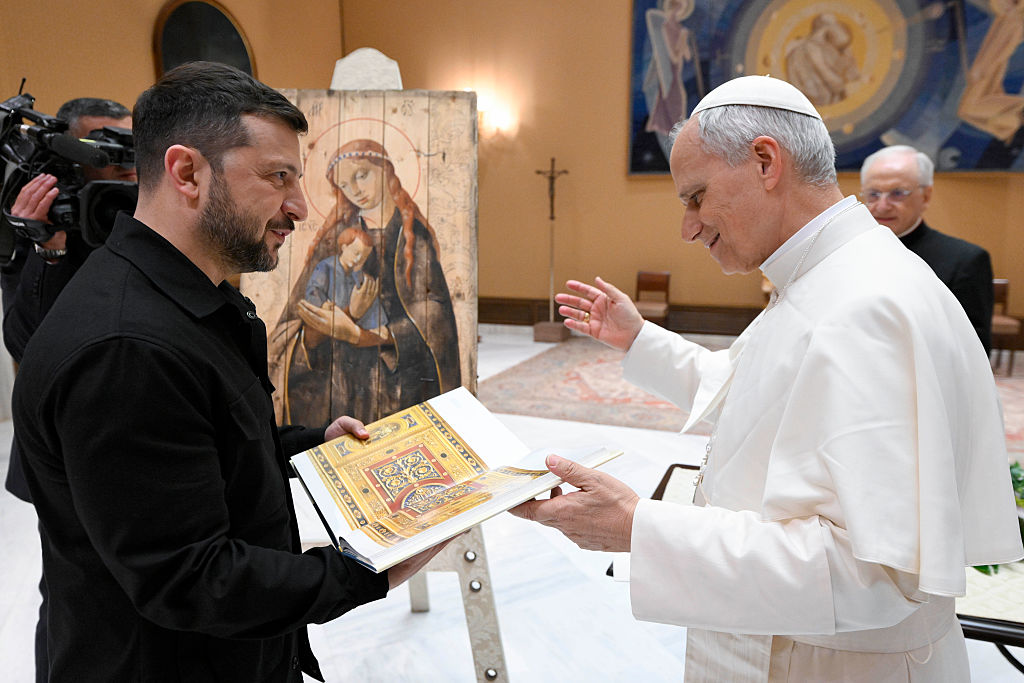On Sunday, following his first Sunday mass as leader of the Roman Catholic Church, Pope Leo XIV met with Ukrainian President Volodymyr Zelenskyy, who marked the occasion with a gift: An image of the Madonna and child painted on a wood panel from an artillery crate used on the frontlines of its war against Russia.
“For many peoples, the image of a mother with a child is a symbol of life that must be protected. Today, we presented Pope Leo XIV with a special icon—The Mother of God with the Infant, painted on a fragment of a box from heavy artillery weapons,” Zelensky wrote on Telegram. “It is about our children. About those who suffered from the war, whom Russia deliberately kidnapped and deported, and whom they are very much waiting for at home, in Ukraine.”
Related Articles

Three years into Russia’s invasion of Ukraine, the two nations appear no closer to a ceasefire. This week, following a phone call between President Donald Trump and Russian President Vladmir Putin, Trump announced that his administration would not pressure Russia to call an immediate end to the warring, which has, as of March 2025, claimed the lives of at least 150,000 Ukrainians and roughly 100,000 Russian soldiers, according to figures published by Kyiv and the United Nations. According to the Washington Post, Trump said that Zelenskyy and Putin should handle negotiations themselves, in a political rebuke to Ukraine’s allies in the European Union, some of whom have called on the Trump administration to sanction Russia.
In his first Sunday address, Pope Leo called for an “authentic, just and lasting peace” in Ukraine. The Supreme Pontiff has reportedly offered to host broker peace talks between Russia and Ukraine at the Vatican. “The Holy See is always ready to help bring enemies together, face to face, to talk to one another,” he said, as quoted by the New York Times.
Earlier this month, the European Union (EU) issued a new round of sanctions against Russia and, in a first, included on the list a museum—the Tauric Chersonese State Museum-Preserve, on the outskirts of the city of Sevastopol in Crimea. Its museum director, Elena Morozova, has also been sanctioned.
“Since the annexation of Crimea, the museum has actively undermined Ukrainian cultural heritage by promoting pro-Russian narratives regarding the cultural significance of the artifacts and excavation sites it administers,” the EU stated in the sanctions document. “Following Russia’s full-scale invasion of Ukraine, the museum has used its platform to promote the invasion and the actors perpetrating it, including organizing deliveries of supplies to the frontlines.”
Last year, Ukrainian cultural officials accused Russia of transforming Tauric Chersonese, an ancient city founded by Greeks in the 5th century BCE and a UNESCO World Heritage Site since 2013, into a “historical and archaeological park.” The site includes a Russian Orthodox monastery and several institutions, including a Museum of Christianity and the Museum of Crimea and Novorossiya (the Russian term for the annexed territories in Crimea).
Ukraine has an overwhelmingly Eastern Orthodox population, with some 70% identifying with the Orthodox Christian Church, which is a separate entity from the Catholic Church and is not beholden to its leadership. In 2019, the Ukrainian Orthodox Church split from the Moscow-based Russian Orthodox Church, a move fueled by millennia-old disagreements over canonical law and modern geopolitical tensions related to the annexation of Crimea.
In his statement, Zelenskyy thanked Pope Leo and the Catholic Church “for its willingness to serve as a platform for direct negotiations between Ukraine and Russia,” and shared these hopes “for dialogue in any format that leads to real results.”

